An Extensive Overview of Islanding Detection Strategies of Active Distributed Generations in Sustainable Microgrids
Abstract
1. Introduction
1.1. Background and Motive
- Grid-forming voltage control units;
- Grid-following current control units.
1.2. Problem Statement and Literature Review
1.3. Limitations of the Existing Research
1.4. Significant Value Additions
- Islanding detection is depicted with a real-time scenario for the better understanding of the readers.
- A detailed and extensive review is presented of the existing international standards regarding the islanding detection issue.
- International test beds are discussed thoroughly that are utilized for NDZ analysis.
- A detailed classification is presented of the IDSs according to state-of-the-art research work.
- The detailed and comprehensive statistical comparative analysis is presented for the better understanding of the readers/researchers.
- The research gap in the field of the IDS problem is highlighted.
- The feature recommendations were also presented for the readers’ understanding.
2. Islanding Detection and Its Standardization
2.1. Islanding Detection by Definition
- “Islanding is a situation when an ADG shelves electrical power even when there is no sustained approach to the main electrical grid”.
- “Islanding is a situation when the grid lost power from the main grid but there is uninterrupted power received by the loads from the distributed generation (DG) units”.
2.2. Standardization of Islanding Detection Methods
2.3. Standard Benchmark Test Systems
2.3.1. UL-1741 International Standard Test Model
2.3.2. IEEE 1547 International Standard Test Model
2.4. Software and Tools
- MATLAB/Simulink software;
- ETAP software;
- DigSilent Power Factory ® software;
- Software phase-lock loop (SPLL) technology;
- HOMER simulation software;
- dSPACE using control desk software;
- PSCADEMTDC software;
- LabVIEW software;
- Hardware in the loop (HIL) by RT lab.
3. Categorization of Islanding Detection Strategies
3.1. Remote IDSs
3.2. Local IDSs
3.2.1. Passive IDSs
- Over/under voltage;
- Rate of change of frequency;
- Over/under frequency;
- Voltage phase jump detection, etc.
3.2.2. Active IDSs
- Negative-sequence current injection;
- Impedance measurement at a specific frequency;
- Impedance measurement;
- Slip mode frequency shift, etc.
3.2.3. Hybrid IDSs
4. Comparative Analysis of Existing Work
- System instability and decreased power quality because of positive feedback;
- NDZ;
- Ineffectiveness or false operation;
- Exorbitant implementation.
5. Research Gap
- First, a summary of common techniques, including remote and local IDSs, was provided.
- The passive, active, and hybrid local IDSs are further divided into three categories. There follows a succinct explanation of signal processing and intelligent-based IDSs.
- Based on the benefits, drawbacks, and different capacity parameters, a thorough comparison of several approaches was offered.
- It is discovered that the NDZ of the passive IDSs is higher than that of the Active and Hybrid approaches.
- Although the NDZ is a less active technique, it lowers the quality of the power.
- In contrast to passive IDS, hybrid IDSs have a lower NDZ and combine the traits of both active and passive IDSs.
- Although the remote IDSs lack NDZ, they are extremely sophisticated when compared to the local approaches.
- Combining signal processing and intelligent schemes is the basic need of the modern world.
- Hardware in the loop validation of a lot of the schemes has not been provided; therefore, new researchers also focused on the specified area.
6. Conclusions and Recommendations
Author Contributions
Funding
Institutional Review Board Statement
Informed Consent Statement
Data Availability Statement
Acknowledgments
Conflicts of Interest
References
- Haider, R.; Ghanbari, T.; Kim, C.H. Islanding Detection Scheme for Inverter-Based Distributed Generation Systems Using Cumulative Reactive Power Harmonics. J. Electr. Eng. Technol. 2019, 14, 1907–1917. [Google Scholar] [CrossRef]
- Ramachandradurai, S.; Krishnan, N.; Prabaharan, N. Unintentional Passive Islanding Detection and Prevention Method with Reduced Non-Detection Zones. Energies 2022, 15, 3038. [Google Scholar] [CrossRef]
- Kumar, A.; Mohapatra, A.; Singh, S.N. Phaselet-Based Limited-Time q-Axis DC Offset Voltage Injection for Detection of Islanding of DG and Fault in a Meshed Microgrid. IEEE Syst. J. 2022, 16, 1379–1390. [Google Scholar] [CrossRef]
- Markovic, U.; Chrysostomou, D.; Aristidou, P.; Hug, G. Impact of inverter-based generation on islanding detection schemes in distribution networks. Electr. Power Syst. Res. 2021, 190, 106610. [Google Scholar] [CrossRef]
- Choudhury, B.K.; Jena, P. Superimposed Impedance-Based Passive Islanding Detection Scheme for DC Microgrids. IEEE J. Emerg. Sel. Top. Power Electron. 2022, 10, 469–483. [Google Scholar] [CrossRef]
- Shah, M.A.; Bukhari, S.B.A.; Imran, K.; Mehmood, K.K.; Mumtaz, F.; Abusorrah, A.; Kazmi, S.A.A.; Wadood, A. High speed protection of medium voltage DC distribution system using modified mathematical morphology. IET Renew. Power Gener. 2022, 16, 3134–3148. [Google Scholar] [CrossRef]
- Chaitanya, B.K.; Yadav, A.; Pazoki, M. An advanced signal decomposition technique for islanding detection in DG system. IEEE Syst. J. 2021, 15, 3220–3229. [Google Scholar] [CrossRef]
- Bhatt, N.; Kumar, A. A Passive Islanding Detection Algorithm Based on Modal Current and Adaptive Boosting. Arab. J. Sci. Eng. 2020, 45, 6791–6801. [Google Scholar] [CrossRef]
- Admasie, S.; Bukhari, S.B.A.; Haider, R.; Gush, T.; Kim, C.H. A passive islanding detection scheme using variational mode decomposition-based mode singular entropy for integrated microgrids. Electr. Power Syst. Res. 2019, 177, 105983. [Google Scholar] [CrossRef]
- Haider, R.; Kim, C.H.; Ghanbari, T.; Bukhari, S.B.A. Harmonic-signature-based islanding detection in grid-connected distributed generation systems using Kalman filter. IET Renew. Power Gener. 2018, 12, 1813–1822. [Google Scholar] [CrossRef]
- Bansal, Y.; Sodhi, R. A Statistical Features Based Generic Passive Islanding Detection Scheme for IIDGs System. IEEE Trans. Power Deliv. 2022, 37, 3176–3188. [Google Scholar] [CrossRef]
- Reddy, K.H. Modified SRFPLL harmonic support island detection in integrated electric grid. Electr. Eng. 2022, 104, 1305–1315. [Google Scholar] [CrossRef]
- Kumar, A.; Panda, R.K.; Mohapatra, A.; Singh, S.N.; Srivastava, S.C. Mode of oscillation based islanding detection of inverter interfaced DG using ESPRIT. Electr. Power Syst. Res. 2021, 200, 107479. [Google Scholar] [CrossRef]
- Zhao, G.; Jiang, C.; Liu, J. Research on the System and Control Strategy of an AC-DC Hybrid Single-Phase Electric Energy Router. Electronics 2019, 8, 970. [Google Scholar] [CrossRef]
- Tsimtsios, A.; Voglitsis, D.; Perpinias, I.; Korkas, C.; Papanikolaou, N. On the Conflict between LVRT and Line Protection in LV Distribution Systems with PVs: A Current-Limitation-Based Solution. Energies 2019, 12, 2909. [Google Scholar] [CrossRef]
- Lopes, L.A.C.; Zhang, Y. Islanding Detection Assessment of Multi-Inverter Systems With Active Frequency Drifting Methods. IEEE Trans. Power Deliv. 2008, 23, 480–486. [Google Scholar] [CrossRef]
- Rostami, A.; Olamaei, J.; Abdi, H. Islanding Detection of Synchronous DG based on Inherent Feature Extracted from Mechanical Power. Iran. J. Sci. Technol. Trans. Electr. Eng. 2019, 43, 919–928. [Google Scholar] [CrossRef]
- Karimi, M.; Farshad, M.; Hong, Q.; Laaksonen, H.; Kauhaniemi, K. An islanding detection technique for inverter-based distributed generation in microgrids. Energies 2021, 14, 130. [Google Scholar] [CrossRef]
- Thomas, S.R.; Krishna, B.M.; Nair, U. Permutation Entropy Thresholding: A Non-Linear Signal Processing Method for Islanding Detection. IETE J. Res. 2020, 2020, 1–15. [Google Scholar] [CrossRef]
- Raeispour, M.; Atrianfar, H.; Davari, M.; Gharehpetian, G.B. Fault-Tolerant, Distributed Control for Emerging, VSC-Based, Islanded Microgrids—An Approach Based on Simultaneous Passive Fault Detection. IEEE Access 2022, 10, 10995–11010. [Google Scholar] [CrossRef]
- Mumtaz, F.; Khan, H.H.; Zafar, A.; Ali, M.U.; Imran, K. A State-Observer-Based Protection Scheme for AC Microgrids with Recurrent Neural Network Assistance. Energies 2022, 15, 8512. [Google Scholar] [CrossRef]
- Shafique, N.; Raza, S.; Bibi, S.; Farhan, M.; Riaz, M. A simplified passive islanding detection technique based on susceptible power indice with zero NDZ. Ain Shams Eng. J. 2022, 13, 101637. [Google Scholar] [CrossRef]
- Mumtaz, F.; Imran, K.; Abusorrah, A.; Bukhari, S.B.A. Harmonic Content-Based Protection Method for Microgrids via 1-Dimensional Recursive Median Filtering Algorithm. Sustainability 2022, 15, 164. [Google Scholar] [CrossRef]
- Mumtaz, F.; Asif, M.; Khan, H.H.; Abbas, S.; Imran, K.; Haider, M.U.; Yousif, M.; Ullah, A. High Impedance Faults Detection and Classification in Renewable Energy-Based Distribution Networks Using Time-Varying Kalman Filtering Technique. Eng. Proc. 2022, 20, 34. [Google Scholar] [CrossRef]
- Anudeep, B.; Nayak, P.K. Sequence Component-Based Improved Passive Islanding Detection Method for Distribution System with Distributed Generations. Int. J. Emerg. Electr. Power Syst. 2019, 20, 20180292. [Google Scholar] [CrossRef]
- Abdi, H.; Rostami, A.; Rezaei, N. A Novel Passive Islanding Detection Scheme for Synchronous-type DG using Load Angle and Mechanical Power Parameters. Electr. Power Syst. Res. 2021, 192, 106968. [Google Scholar] [CrossRef]
- Wang, G. Design Consideration and Performance Analysis of a Hybrid Islanding Detection Method Combining Voltage Unbalance/Total Harmonic Distortion and Bilateral Reactive Power Variation. CPSS Trans. Power Electron. Appl. 2020, 5, 86–100. [Google Scholar] [CrossRef]
- Mumtaz, F.; Imran, K.; Bukhari, S.B.A.; Mehmood, K.K.; Abusorrah, A.; Shah, M.A.; Kazmi, S.A.A. A Kalman Filter-Based Protection Strategy for Microgrids. IEEE Access 2022, 10, 73243–73256. [Google Scholar] [CrossRef]
- Arif, A.; Imran, K.; Cui, Q.; Weng, Y. Islanding Detection for Inverter-Based Distributed Generation Using Unsupervised Anomaly Detection. IEEE Access 2021, 9, 90947–90963. [Google Scholar] [CrossRef]
- Haider, M.U.; Mumtaz, F.; Khan, H.H.; Asif, M.; Rashid, M.S.; Abbas, S.R.; Zeeshan, M. Smart Energy Meters in Renewable-Energy-Based Power Networks: An Extensive Review. Eng. Proc. 2022, 20, 23. [Google Scholar] [CrossRef]
- Zamani, R.; Golshan, M.E.H.; Alhelou, H.H.; Hatziargyriou, N. A Novel Synchronous DGs Islanding Detection Method based on Online Dynamic Features Extraction. Electr. Power Syst. Res. 2021, 195, 107180. [Google Scholar] [CrossRef]
- Dutta, S.; Olla, S.; Sadhu, P.K. A secured, reliable and accurate unplanned island detection method in a renewable energy based microgrid. Eng. Sci. Technol. Int. J. 2021, 24, 1102–1115. [Google Scholar] [CrossRef]
- Xie, X.; Huang, C.; Li, D. A new passive islanding detection approach considering the dynamic behavior of load in microgrid. Int. J. Electr. Power Energy Syst. 2020, 117, 105619. [Google Scholar] [CrossRef]
- Zamani, R.; Moghaddam, M.P.; Panahi, H.; Sanaye-Pasand, M. Fast Islanding Detection of Nested Grids including Multiple Resources Based on Phase Criteria. IEEE Trans. Smart Grid 2021, 12, 4962–4970. [Google Scholar] [CrossRef]
- Reddy, C.R.; Reddy, K.H. A new passive islanding detection technique for integrated distributed generation system using rate of change of regulator voltage over reactive power at balanced islanding. J. Electr. Eng. Technol. 2019, 14, 527–534. [Google Scholar] [CrossRef]
- Ansari, S.; Gupta, O.H. Voltage Ripple-Based Islanding Technique on Modified IEEE-13 Bus Test Feeder for Photovoltaic Inverter. Lect. Notes Electr. Eng. 2021, 699, 139–155. [Google Scholar] [CrossRef]
- Kumar, P.; Kumar, V.; Tyagi, B. Islanding detection for reconfigurable microgrid with RES. IET Gener. Transm. Distrib. 2021, 15, 1187–1202. [Google Scholar] [CrossRef]
- Reddy, C.R.; Reddy, K.H. Passive islanding detection technique for integrated distributed generation at zero power balanced islanding. Int. J. Integr. Eng. 2019, 11, 126–137. [Google Scholar] [CrossRef]
- Kim, M.S.; Haider, R.; Cho, G.J.; Kim, C.H.; Won, C.Y.; Chai, J.S. Comprehensive review of islanding detection methods for distributed generation systems. Energies 2019, 12, 837. [Google Scholar] [CrossRef]
- Raju, L.B.; Rao, K.S. Evaluation of Passive Islanding Detection Methods for Line to Ground Unsymmetrical Fault in Three Phase Microgrid Systems: Microgrid Islanding Detection Method. Eng. Technol. Appl. Sci. Res. 2021, 11, 7591–7597. [Google Scholar] [CrossRef]
- Nale, R.; Biswal, M.; Kishor, N. A passive communication based islanding detection technique for AC microgrid. Int. J. Electr. Power Energy Syst. 2022, 137, 107657. [Google Scholar] [CrossRef]
- Matic-Cuka, B.; Kezunovic, M. Islanding detection for inverter-based distributed generation using support vector machine method. IEEE Trans. Smart Grid 2014, 5, 2676–2686. [Google Scholar] [CrossRef]
- Vieira, T.C.; Grilo, A.P.; Teixeira, J.C.; dos Santos, R.C. Methodology for Assessing the Risk of Unintentional Islanding of Distributed Wind Generators Using Passive Schemes. J. Control Autom. Electr. Syst. 2020, 31, 177–188. [Google Scholar] [CrossRef]
- Zamani, R.; Hamedani-Golshan, M.-E.; Haes Alhelou, H.; Siano, P.; R. Pota, H. Islanding Detection of Synchronous Distributed Generator Based on the Active and Reactive Power Control Loops. Energies 2018, 11, 2819. [Google Scholar] [CrossRef]
- Liu, M.; Zhao, W.; Wang, Q.; Huang, S.; Shi, K. An Irregular Current Injection Islanding Detection Method Based on an Improved Impedance Measurement Scheme. Energies 2018, 11, 2474. [Google Scholar] [CrossRef]
- Arefin, A.A.; Baba, M.; Singh, N.S.S.; Nor, N.B.M.; Sheikh, M.A.; Kannan, R.; Abro, G.E.M.; Mathur, N. Review of the Techniques of the Data Analytics and Islanding Detection of Distribution Systems Using Phasor Measurement Unit Data. Electronics 2022, 11, 2967. [Google Scholar] [CrossRef]
- Baloch, S.; Jamali, S.Z.; Shah, S.A.R. A Protection Technique for Microgrid Using Wavelet Packet Transform and Data Mining Classifier. Eng. Proc. 2022, 20, 33. [Google Scholar] [CrossRef]
- Swarnkar, N.K.; Mahela, O.P.; Khan, B.; Lalwani, M. Identification of Islanding Events in Utility Grid with Renewable Energy Penetration Using Current Based Passive Method. IEEE Access 2021, 9, 93781–93794. [Google Scholar] [CrossRef]
- Ke, J.; Zhengxuan, Z.; Qijuan, Z.; Zhe, Y.; Tianshu, B. Islanding detection method of multi-port photovoltaic DC micro grid based on harmonic impedance measurement. IET Renew. Power Gener. 2019, 13, 2604–2611. [Google Scholar] [CrossRef]
- Elshrief, Y.A.; Abd-Elhaleem, S.; Kujabi, S.; Helmi, D.H.; Abozalam, B.A.; Asham, A.D. Zero Non-Detection Zone for Islanding Detection Based on a Novel Hybrid Passive-Active Technique with Fuzzy Inference System. Sustainability 2022, 14, 6325. [Google Scholar] [CrossRef]
- Bukhari, S.B.A.; Mehmood, K.K.; Wadood, A.; Park, H. Intelligent Islanding Detection of Microgrids Using Long Short-Term Memory Networks. Energies 2021, 14, 5762. [Google Scholar] [CrossRef]
- Arefin, A.A.; Hasan, K.N.B.M.; Othman, M.L.; Romlie, M.F.; Saad, N.; Nor, N.B.M.; Abdullah, M.F. A Novel Island Detection Threshold Setting Using Phasor Measurement Unit Voltage Angle in a Distribution Network. Energies 2021, 14, 4877. [Google Scholar] [CrossRef]
- Dash, P.K.; Barik, S.K.; Patnaik, R.K. Detection and Classification of Islanding and Nonislanding Events in Distributed Generation Based on Fuzzy Decision Tree. J. Control Autom. Electr. Syst. 2014, 25, 699–719. [Google Scholar] [CrossRef]
- Barkat, F.; Cheknane, A.; Guerrero, J.M.; Lashab, A.; Istrate, M.; Gavrilas, M.; Motas, J.G.; Banu, I.V. Review, analysis, and performance evaluation of the most common four active methods for islanding detection in grid-connected photovoltaic systems. Electr. Power Syst. Res. 2023, 214, 108909. [Google Scholar] [CrossRef]
- Guan, Z.; Liao, Y. A New islanding detection method based on wavelet-Transform and ann for micro-grid including inverter assisted distributed generator. Int. J. Emerg. Electr. Power Syst. 2019, 20, 20190074. [Google Scholar] [CrossRef]
- Nougain, V.; Prakash, S.; Mishra, S. Hybrid Islanding Detection Method based on ROCOF over Reactive Power and d-Axis Current Injection. In Proceedings of the 2018 8th IEEE India International Conference on Power Electronics (IICPE), Jaipur, India, 13–15 December 2018; pp. 1–4. [Google Scholar] [CrossRef]
- Mishra, P.P.; Bhende, C.N. A passive islanding detection technique with reduced complexity for distributed generations. In Proceedings of the 2017 7th International Conference on Power Systems (ICPS), Pune, India, 21–23 December 2017; pp. 830–835. [Google Scholar] [CrossRef]
- Tajdinian, M.; Khosravi, H.; Samet, H.; Ali, Z.M. Islanding Detection Scheme Using Potential Energy Function Based Criterion. Electr. Power Syst. Res. 2022, 209, 108047. [Google Scholar] [CrossRef]
- Chauhan, K.; Sodhi, R. A distribution-level PMU enabled Teager-Kaiser energy based islanding detector. Electr. Power Syst. Res. 2021, 192, 106964. [Google Scholar] [CrossRef]
- Gush, T.; Bukhari, S.B.A.; Haider, R.; Admasie, S.; Oh, Y.-S.; Cho, G.-J.; Kim, C.-H. Fault detection and location in a microgrid using mathematical morphology and recursive least square methods. Int. J. Electr. Power Energy Syst. 2018, 102, 324–331. [Google Scholar] [CrossRef]
- Xie, D.; Zang, D.; Gao, P.; Xiang, M.; Yang, L. Research on islanding detection technology for multi grid-connected inverters. In Proceedings of the 2017 IEEE 2nd Advanced Information Technology, Electronic and Automation Control Conference (IAEAC), Chongqing, China, 25–26 March 2017; pp. 2505–2508. [Google Scholar] [CrossRef]
- Shukla, A.; Dutta, S.; Sadhu, P.K. An island detection approach by μ-PMU with reduced chances of cyber attack. Int. J. Electr. Power Energy Syst. 2021, 126, 106599. [Google Scholar] [CrossRef]
- Tao, J.; Han, H.; Wang, Z.; Shu, Y.; Fang, W.; Li, Y. An Advanced Islanding Detection Strategy Coordinating the Newly Proposed V Detection and the ROCOF Detection. In Proceedings of the 2018 IEEE Innovative Smart Grid Technologies—Asia (ISGT Asia), Singapore, 22–25 May 2018; pp. 1204–1208. [Google Scholar] [CrossRef]
- Laaksonen, H.; Hovila, P. Islanding Detection During Intended Island Operation of Nested Microgrid. In Proceedings of the 2018 IEEE PES Innovative Smart Grid Technologies Conference Europe (ISGT-Europe), Sarajevo, Bosnia and Herzegovina, 21–25 October 2018; pp. 1–6. [Google Scholar] [CrossRef]
- Zeineldin, H.H.; Kirtley, J.L. A simple technique for islanding detection with negligible nondetection zone. IEEE Trans. Power Deliv. 2009, 24, 779–786. [Google Scholar] [CrossRef]
- Bezawada, P.; Yeddula, P.O.; Kota, V.R. A Novel Time-Domain Passive Islanding Detection Technique for Grid-Connected Hybrid Distributed Generation System. Arab. J. Sci. Eng. 2021, 46, 9867–9877. [Google Scholar] [CrossRef]
- Yao, X.; Tan, B.; Hu, C. Islanding detection for PV plant using instantaneous power theory. In Proceedings of the 2016 IEEE Advanced Information Management, Communicates, Electronic and Automation Control Conference (IMCEC), Xi’an, China, 3–5 October 2016; pp. 1495–1498. [Google Scholar] [CrossRef]
- Guo, Z. A harmonic current injection control scheme for active islanding detection of grid-connected inverters. In Proceedings of the 2015 IEEE International Telecommunications Energy Conference (INTELEC), Osaka, Japan, 18–22 October 2015; pp. 1–5. [Google Scholar] [CrossRef]
- Gallagher, N.; Wise, G. A theoretical analysis of the properties of median filters. IEEE Trans. Acoust. Speech Signal Process. 1981, 29, 1136–1141. [Google Scholar] [CrossRef]
- Elshrief, Y.A.; Helmi, D.H.; Abd-Elhaleem, S.; Abozalam, B.A.; Asham, A.D. Fast and accurate islanding detection technique for microgrid connected to photovoltaic system. J. Radiat. Res. Appl. Sci. 2021, 14, 210–221. [Google Scholar] [CrossRef]
- Huayang, W.; Zuyuan, Y.; Long, Z.; Yuan, C. Based on hybrid algorithm of distributed power islanding detection. In Proceedings of the 2016 IEEE Advanced Information Management, Communicates, Electronic and Automation Control Conference (IMCEC), Xi’an, China, 3–5 October 2016; pp. 1360–1364. [Google Scholar] [CrossRef]
- Cui, Q.; El-Arroudi, K.; Joós, G. Islanding Detection of Hybrid Distributed Generation Under Reduced Non-Detection Zone. IEEE Trans. Smart Grid 2018, 9, 5027–5037. [Google Scholar] [CrossRef]
- Worku, M.Y.; Hassan, M.A.; Maraaba, L.S.; Abido, M.A. Islanding detection methods for microgrids: A comprehensive review. Mathematics 2021, 9, 3174. [Google Scholar] [CrossRef]
- Kermany, S.D.; Joorabian, M.; Deilami, S.; Masoum, M.A.S. Hybrid Islanding Detection in Microgrid With Multiple Connection Points to Smart Grids Using Fuzzy-Neural Network. IEEE Trans. Power Syst. 2017, 32, 2640–2651. [Google Scholar] [CrossRef]
- Pouryekta, A.; Ramachandaramurthy, V.K.; Mithulananthan, N.; Arulampalam, A. Islanding Detection and Enhancement of Microgrid Performance. IEEE Syst. J. 2018, 12, 3131–3141. [Google Scholar] [CrossRef]
- Zamani, R.; Golshan, M.E.H. Islanding detection of synchronous machine-based distributed generators using signal trajectory pattern recognition. In Proceedings of the 2018 6th International Istanbul Smart Grids and Cities Congress and Fair (ICSG), Istanbul, Turkey, 25–26 April 2018; pp. 91–95. [Google Scholar] [CrossRef]
- Perlenfein, S.; Cui, Y.; Ropp, M. Islanding and Single Phase Open Detection Effectiveness of a Subharmonic PLCP Based Island Detection System. In Proceedings of the 2018 IEEE 7th World Conference on Photovoltaic Energy Conversion (WCPEC) (A Joint Conference of 45th IEEE PVSC, 28th PVSEC & 34th EU PVSEC), Waikoloa, HI, USA, 10–15 June 2018; pp. 1457–1461. [Google Scholar] [CrossRef]
- Cheng, Y.H.; Chen, K.; Yin, C.; Zhang, J.; Bai, L.B. An improved active islanding detection method applying to multi-inverter power system. In Proceedings of the 2015 IEEE International Conference on Applied Superconductivity and Electromagnetic Devices (ASEMD), Shanghai, China, 20–23 November 2015; pp. 561–562. [Google Scholar] [CrossRef]
- Mishra, M.; Rout, P.K. Fast discrete s-transform and extreme learning machine based approach to islanding detection in grid-connected distributed generation. Energy Syst. 2019, 10, 757–789. [Google Scholar] [CrossRef]
- Özcanlı, A.K.; Baysal, M. A novel Multi-LSTM based deep learning method for islanding detection in the microgrid. Electr. Power Syst. Res. 2022, 202, 107574. [Google Scholar] [CrossRef]
- Khamis, A.; Shareef, H.; Bizkevelci, E.; Khatib, T. A review of islanding detection techniques for renewable distributed generation systems. Renew. Sustain. Energy Rev. 2013, 28, 483–493. [Google Scholar] [CrossRef]
- Naraghipour, K.; Ahmed, K.; Booth, C. A Comprehensive Review of Islanding Detection Methods for Distribution Systems. In Proceedings of the 9th International Conference on Renewable Energy Research and Applications, ICRERA 2020, Glasgow, UK, 27–30 September 2020; pp. 428–433. [Google Scholar] [CrossRef]
- Alyasiri, A.M.M.; Kurnaz, S. Passive islanding detection in microgrids using artificial neural networks. Appl. Nanosci. 2022, 2022, 1–16. [Google Scholar] [CrossRef]
- Reddy, R.; Reddy, G.R.; Goud, B.S.; Rajeswaran, N.; Kumar, N. Passive Islanding Detection Methods for Integrated Distributed Generation System. J. Power Technol. 2021, 101, 127–134. [Google Scholar]
- Anne, R.; Basha, F.K.; Palaniappan, R.; Oliver, K.L.; Thompson, M.J. Reliable Generator Islanding Detection for Industrial Power Consumers With On-Site Generation. IEEE Trans. Ind. Appl. 2016, 52, 668–676. [Google Scholar] [CrossRef]
- Laaksonen, H. Advanced Islanding Detection Functionality for Future Electricity Distribution Networks. IEEE Trans. Power Deliv. 2013, 28, 2056–2064. [Google Scholar] [CrossRef]
- Mumtaz, F.; Shah, M.A.; Khan, H.H.; Naz, H.U.; Imran, K.; Haider, M.U. Incipient fault detection in active-distribution networks based on Time-varying Kalman Filter. In Proceedings of the 6th International Conference on Energy, Environment and Sustainable Development, Eskisehir, Turkey, 23–25 September 2022. [Google Scholar]
- Gupta, P.; Bhatia, R.S.; Jain, D.K. Active ROCOF Relay for Islanding Detection. IEEE Trans. Power Deliv. 2017, 32, 420–429. [Google Scholar] [CrossRef]
- Fu, N.; Deng, J.; Wang, Z.; Wang, W.; Wang, S. A Hybrid Mode Control Strategy for LCC-LCC- Compensated WPT System with Wide ZVS Operation. IEEE Trans. Power Electron. 2022, 37, 2449–2460. [Google Scholar] [CrossRef]
- Makwana, Y.M.; Bhalja, B.R. Experimental Performance of an Islanding Detection Scheme Based on Modal Components. IEEE Trans. Smart Grid 2019, 10, 1025–1035. [Google Scholar] [CrossRef]
- Ray, P.K.; Kishor, N.; Mohanty, S.R. Islanding and power quality disturbance detection in grid-connected hybrid power system using wavelet and S-transform. IEEE Trans. Smart Grid 2012, 3, 1082–1094. [Google Scholar] [CrossRef]
- Bekhradian, R.; Davarpanah, M.; Sanaye-Pasand, M. Novel Approach for Secure Islanding Detection in Synchronous Generator Based Microgrids. IEEE Trans. Power Deliv. 2019, 34, 457–466. [Google Scholar] [CrossRef]
- Kulkarni, N.K.; Khedkar, M.K. Methods to Detect the Occurrence of an Unintentional Island with Passive Approach: A Review. J. Inst. Eng. Ser. B 2021, 102, 1091–1111. [Google Scholar] [CrossRef]
- Arguence, O.; Raison, B.; Cadoux, F. Comments on Impact of Load Frequency Dependence on the NDZ and Performance of the SFS Islanding Detection Method. IEEE Trans. Ind. Electron. 2017, 64, 7277–7279. [Google Scholar] [CrossRef]
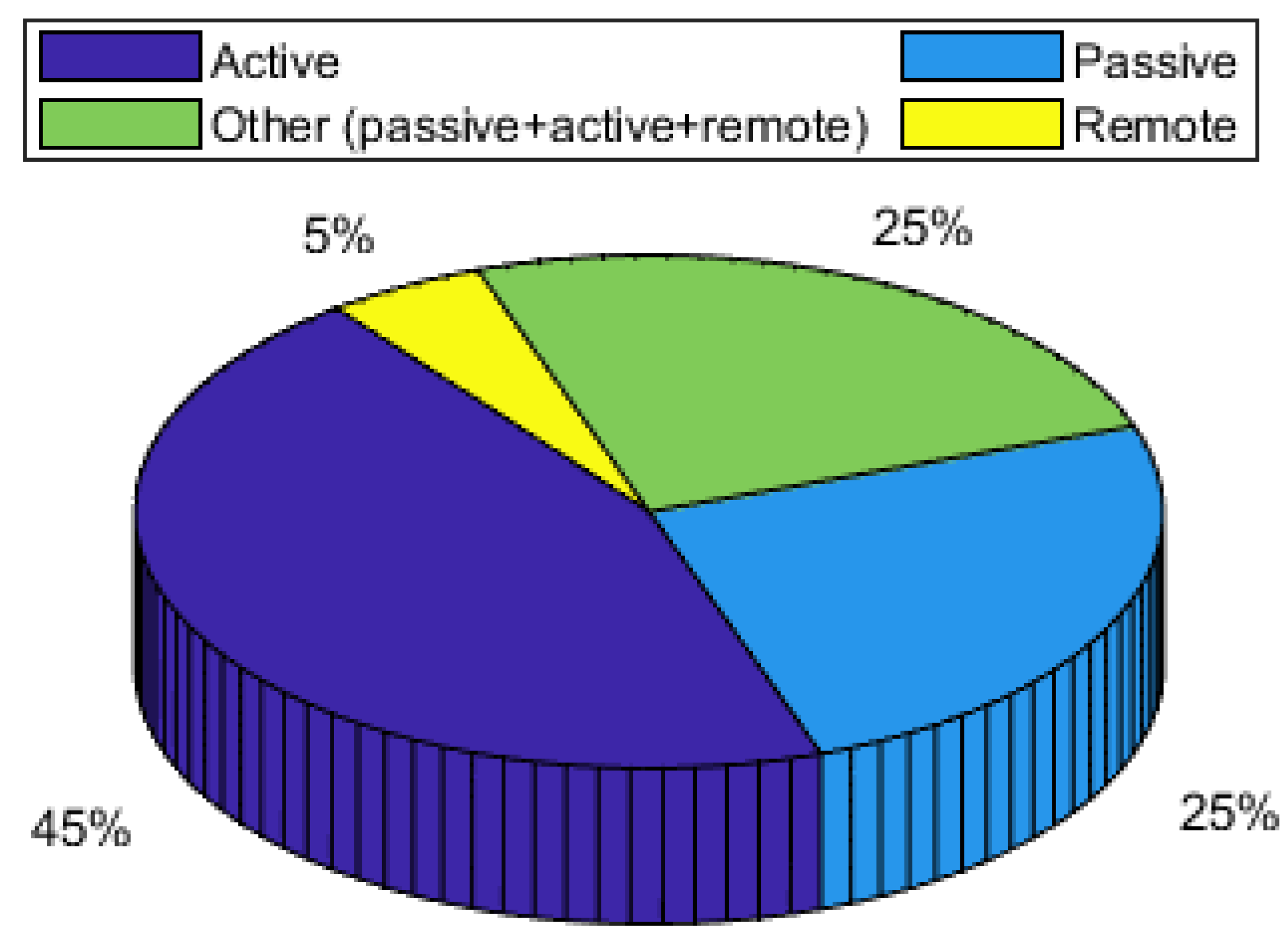
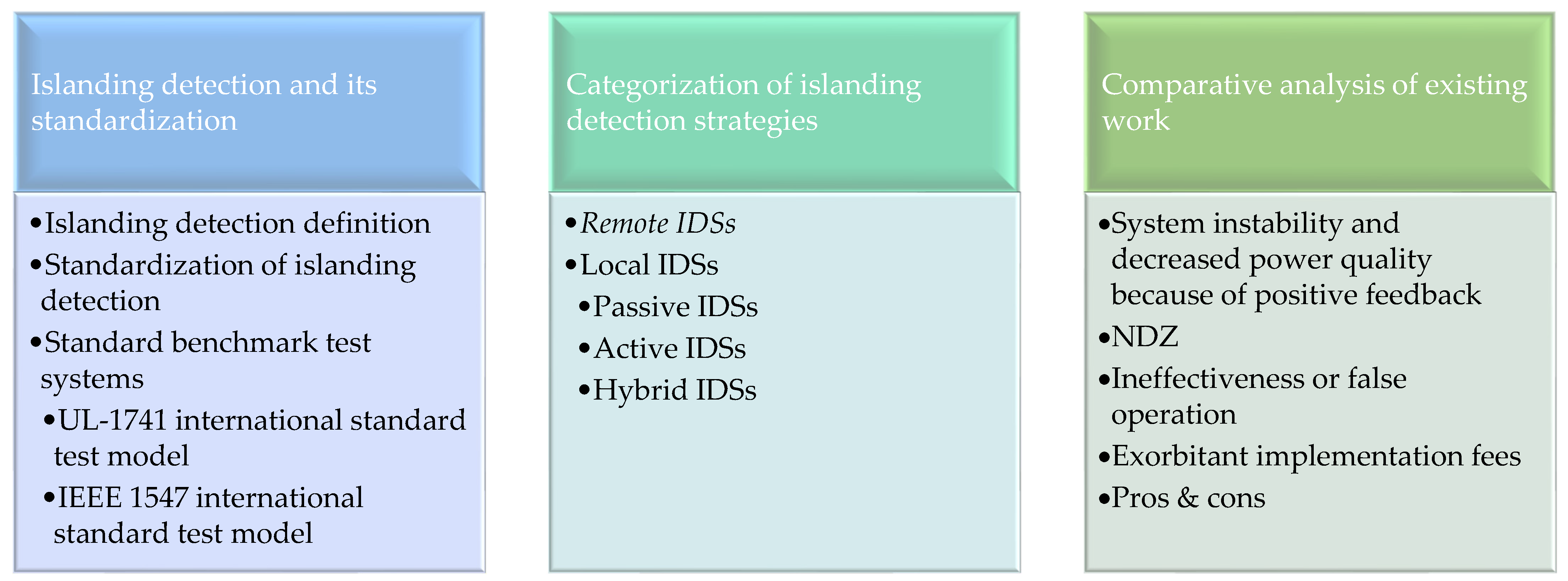
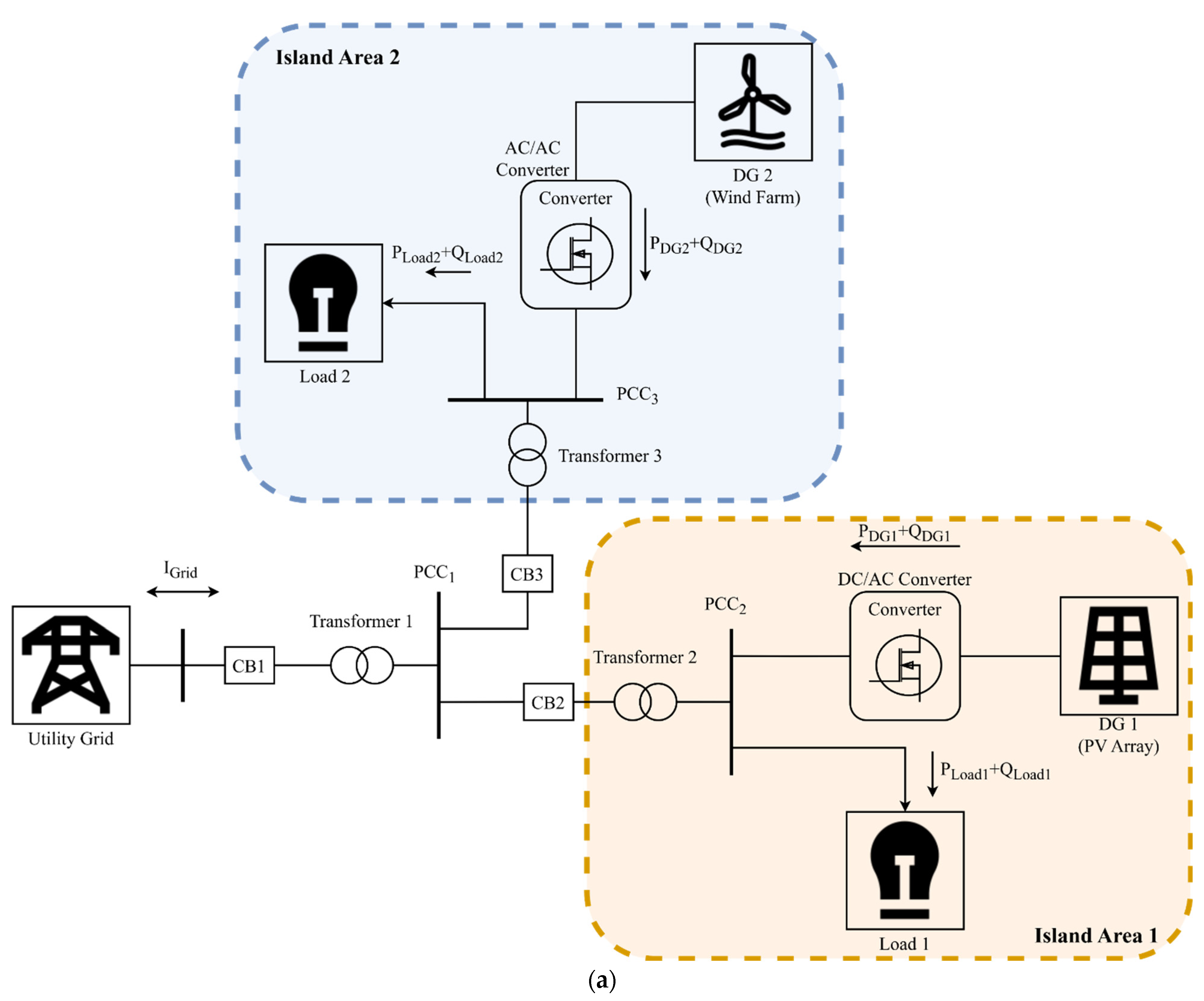


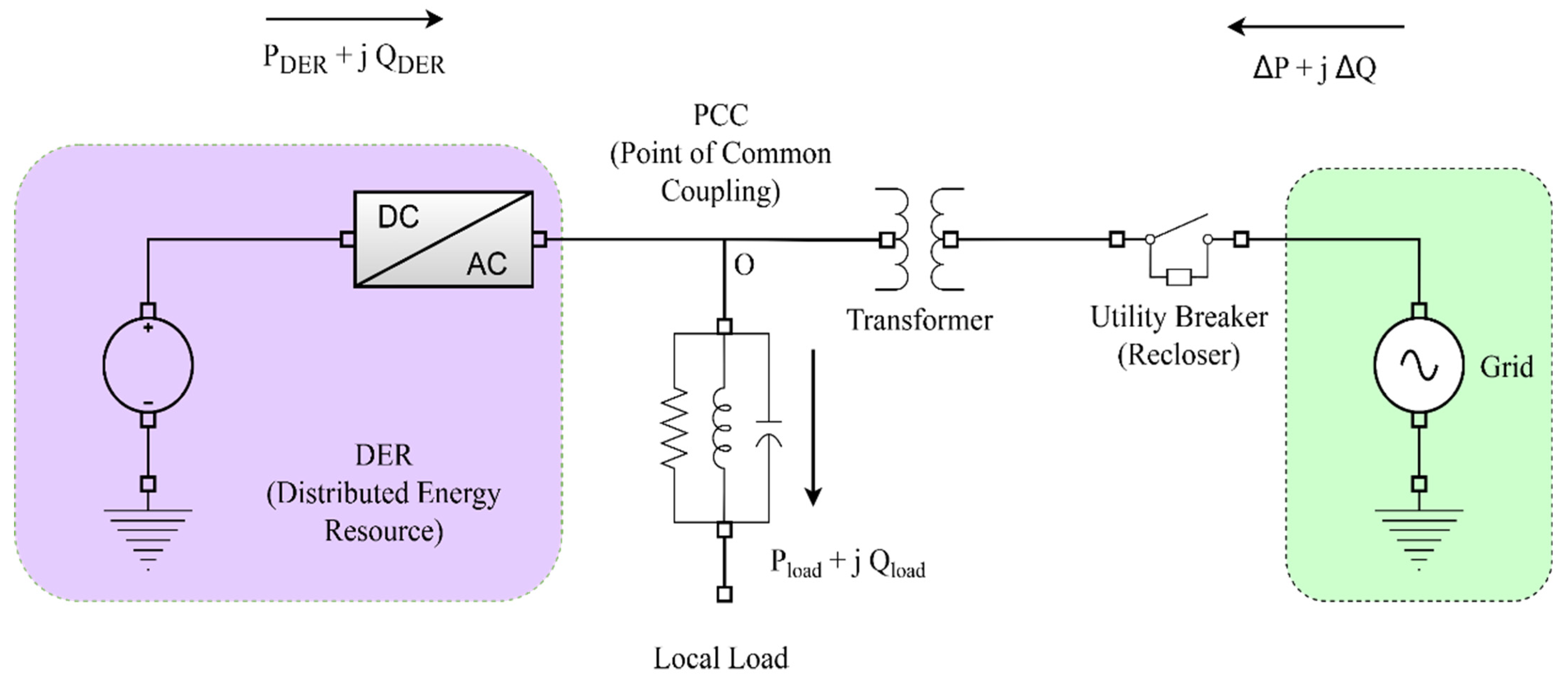

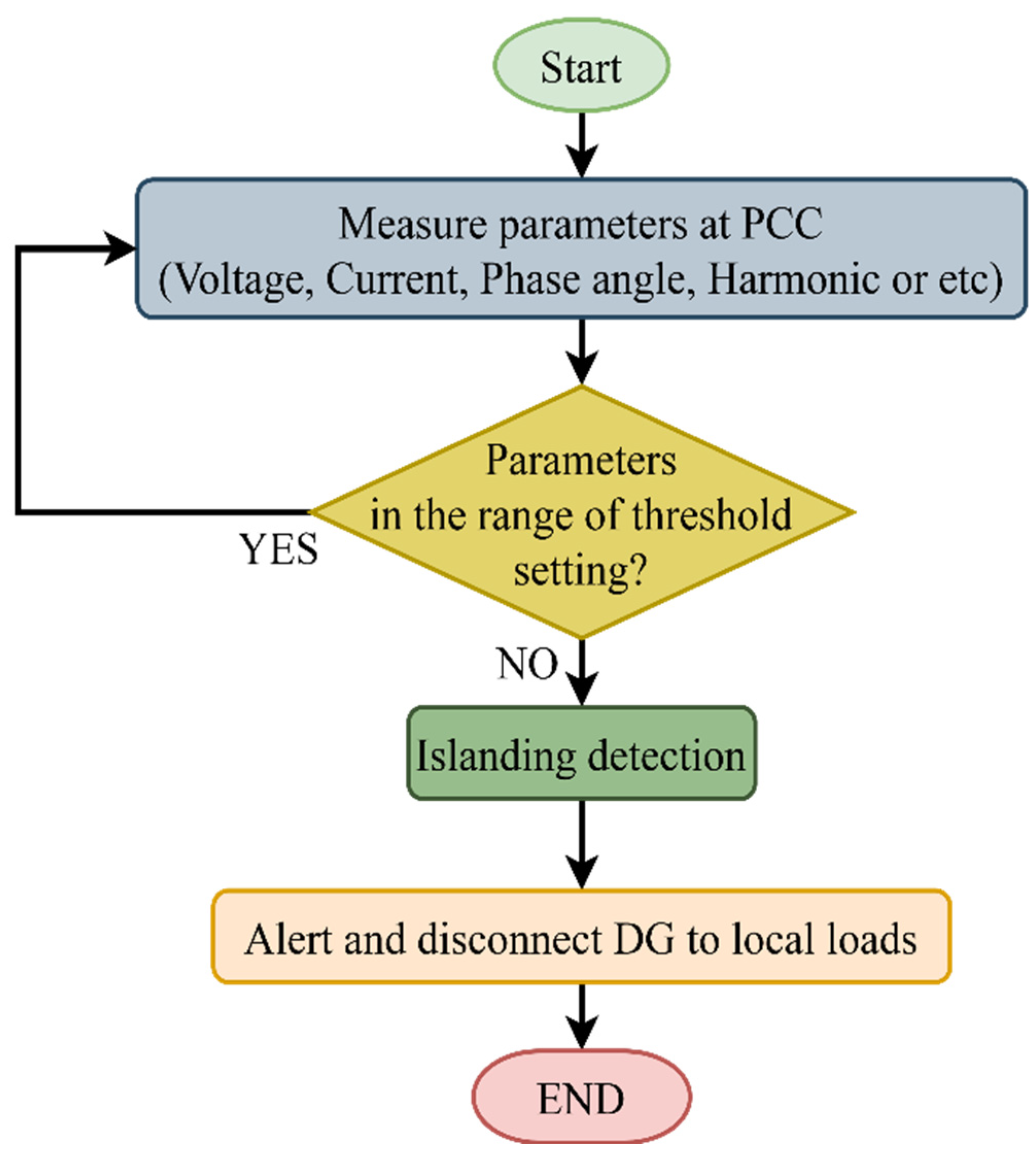
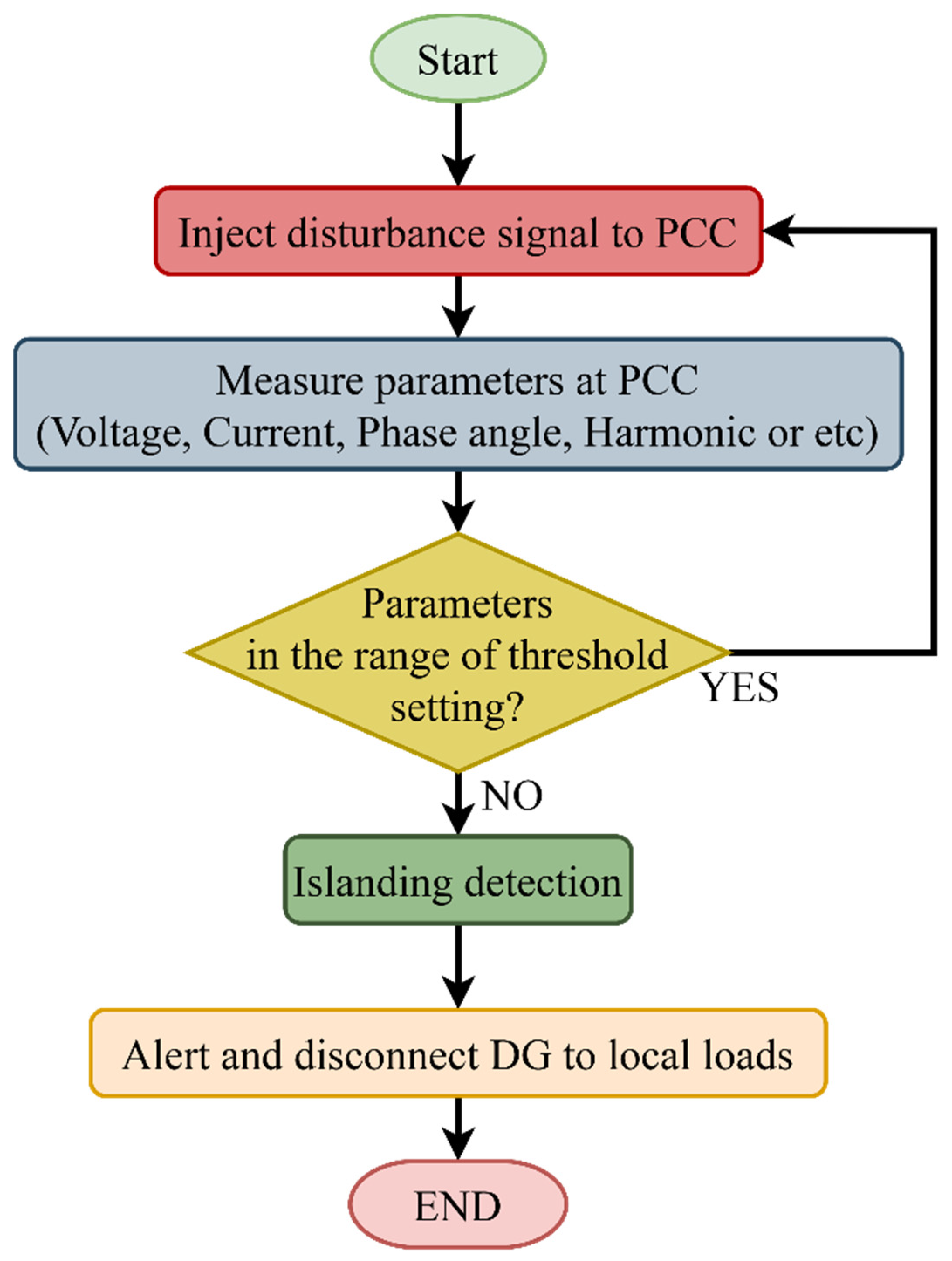
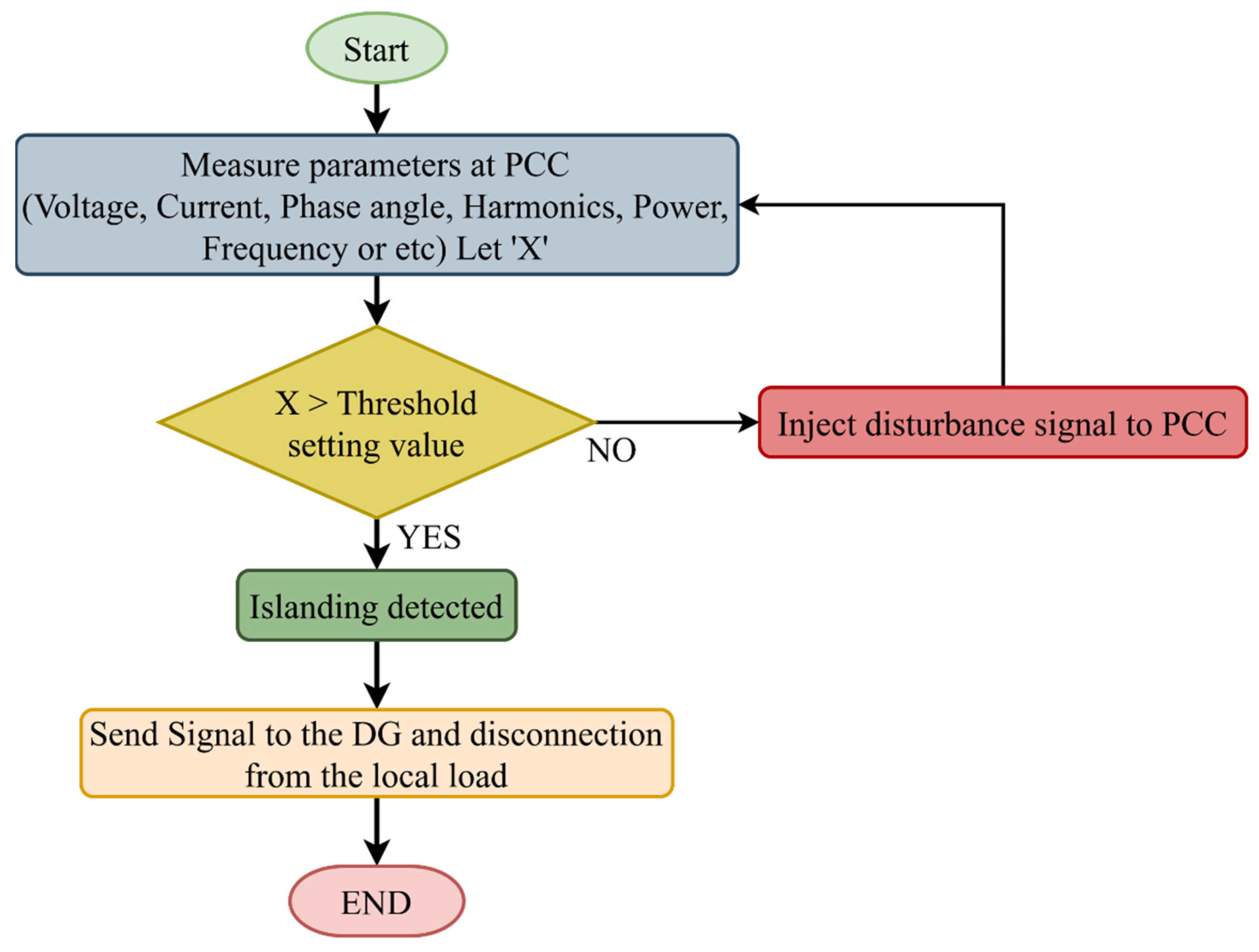
| Standards | IEEE1547.1 | IEEE929 (2000) | BS EN 62116 | BS EN 50160 | |
|---|---|---|---|---|---|
| Parameters | |||||
| Network frequency | 60 Hz | 60 Hz | 50 Hz | 50 Hz | |
| Qf | 1 | 2.5 | 1 | 1 | |
| Islanding detection time | <2 s | <2 s | <2 s | <2 s | |
| Voltage threshold | 0.8 to 1.1 Pu | 0.8 to 1.1 Pu | 0.85 to 1.15 Pu | 0.9 to 1.1 Pu | |
| Frequency threshold | 50.3 to 60.5 Hz | 50.3 to 60.5 Hz | 48.5 to 51.5 Hz | 49 to 51 Hz | |
| Software and Tools | Advantages | Disadvantages |
|---|---|---|
| MATLAB/Simulink software [40,66] |
|
|
| ETAP software |
|
|
| DigSilent Power Factory ® software [16,45] |
|
|
| HOMER simulation software [74,75] |
|
|
| PSCADEMTDC software [35] |
|
|
| LabVIEW software [28] |
|
|
| Hardware in the loop (HIL) by RT lab [10] |
|
|
| Islanding Detection IDSs | Remote IDSs | Local IDSs | ||
|---|---|---|---|---|
| Passive IDSs | Active IDSs | Hybrid IDSs | ||
| Examples |
|
|
|
|
| Pros | Highly reliable | Can identify islanding even when generation and demand in an island system are perfectly matched (small NDZ) [27,66]. |
| |
| Cons | Execution expenses are high, particularly for small networks [74,75,90,91,92,93,94] |
| As both passive and active methods are used, the islanding detection time is increased. | |
Disclaimer/Publisher’s Note: The statements, opinions and data contained in all publications are solely those of the individual author(s) and contributor(s) and not of MDPI and/or the editor(s). MDPI and/or the editor(s) disclaim responsibility for any injury to people or property resulting from any ideas, methods, instructions or products referred to in the content. |
© 2023 by the authors. Licensee MDPI, Basel, Switzerland. This article is an open access article distributed under the terms and conditions of the Creative Commons Attribution (CC BY) license (https://creativecommons.org/licenses/by/4.0/).
Share and Cite
Mumtaz, F.; Imran, K.; Abusorrah, A.; Bukhari, S.B.A. An Extensive Overview of Islanding Detection Strategies of Active Distributed Generations in Sustainable Microgrids. Sustainability 2023, 15, 4456. https://doi.org/10.3390/su15054456
Mumtaz F, Imran K, Abusorrah A, Bukhari SBA. An Extensive Overview of Islanding Detection Strategies of Active Distributed Generations in Sustainable Microgrids. Sustainability. 2023; 15(5):4456. https://doi.org/10.3390/su15054456
Chicago/Turabian StyleMumtaz, Faisal, Kashif Imran, Abdullah Abusorrah, and Syed Basit Ali Bukhari. 2023. "An Extensive Overview of Islanding Detection Strategies of Active Distributed Generations in Sustainable Microgrids" Sustainability 15, no. 5: 4456. https://doi.org/10.3390/su15054456
APA StyleMumtaz, F., Imran, K., Abusorrah, A., & Bukhari, S. B. A. (2023). An Extensive Overview of Islanding Detection Strategies of Active Distributed Generations in Sustainable Microgrids. Sustainability, 15(5), 4456. https://doi.org/10.3390/su15054456







